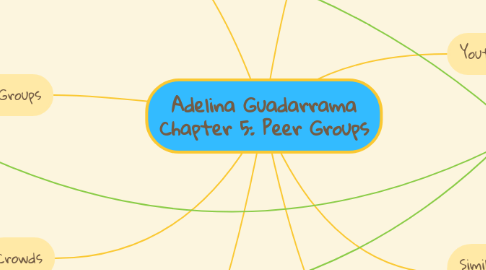
1. Cliques: small groups of 2 and 12 students. usually same sex, same age.
1.1. some cliques can become a clique that antagonizes others that are not part of their group. This can lead to other issues.
1.1.1. cliques provide a social context where adolescents are consistently interacting with other people.
1.1.2. Isolates: few or no links to others in the network.
1.1.3. "Mean Girls" : girls are more aware and distressed by it and are more victimized by mean actions.
1.1.3.1. Relational Aggression: acts intended to harm another through manipulation of his/her relationships with others; as in malicious gossip.
1.2. Structural Transformation: when opposite sex students begin to feel feelings for one another the clique can become split off into mixed-sex cliques.
1.2.1. usually led by the clique leader and then followed by the rest of the members.
2. Reference Groups
2.1. provide members with identity in the eyes of other adolescents. Judge one another on the basis of who they hang out with.
2.1.1. these labels include, jocks, brains, druggies, skaters. The discriptions can be innacurate or accurate when describing individuals' interests.
3. Crowds
3.1. can be caegorized in two dimensions:
3.2. 1. How involved they are in the peer culture
3.3. 2. How involved they are in adult interactions.
4. Bullying
4.1. cyberbullying: bullying that occurs over the internet or cell phone.
4.1.1. usually adolescents who are bullies in person will engage in cyberbullying as well.
4.1.1.1. Victims will report low self-esteem and that they are picked on due to academic performance, school engagement and other factors.
4.2. Popularity types: Sociometric: how well-liked someone is & there is also Perceived: how much status someone has.
4.3. Unpopular adolescents fall into 3 categories
4.3.1. 1. aggressive adolescents
4.3.2. 2. Withdrawn Adolescents
4.3.3. 3. Adolescents who are both aggressive and withdrawn.
5. Peer Groups: groups of people who are roughly the same age. Have become an important context in which adolescents spend time in.
5.1. there is a rise of peer groups due to the spread of secondary education and changes of size of cohorts in adolescence.
6. Youth Culture
6.1. age segregation: where adolescents become so segregated and hold so much connection to their own age- that they close all other ages off.
6.1.1. leading to little to no knowledge about adult values.
6.1.1.1. an issue because an adolescent when emerging through adulthood will miss out on valuable experiences from adults.
6.2. social scientists not sure if peer groups is a concern or celebration.
6.2.1. so subjective because some peer groups are positive and others negative depending on how those individuals perceive the world and their values.

